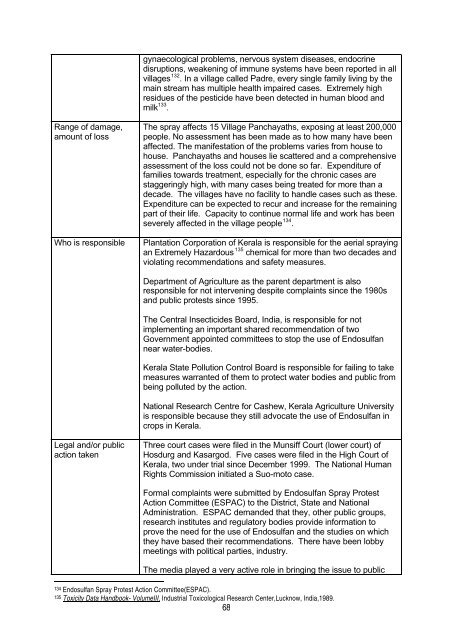Umweltverbrechen multinationaler Konzerne - Greenpeace
Umweltverbrechen multinationaler Konzerne - Greenpeace
Umweltverbrechen multinationaler Konzerne - Greenpeace
Erfolgreiche ePaper selbst erstellen
Machen Sie aus Ihren PDF Publikationen ein blätterbares Flipbook mit unserer einzigartigen Google optimierten e-Paper Software.
Range of damage,<br />
amount of loss<br />
gynaecological problems, nervous system diseases, endocrine<br />
disruptions, weakening of immune systems have been reported in all<br />
villages 132 . In a village called Padre, every single family living by the<br />
main stream has multiple health impaired cases. Extremely high<br />
residues of the pesticide have been detected in human blood and<br />
milk 133 .<br />
The spray affects 15 Village Panchayaths, exposing at least 200,000<br />
people. No assessment has been made as to how many have been<br />
affected. The manifestation of the problems varies from house to<br />
house. Panchayaths and houses lie scattered and a comprehensive<br />
assessment of the loss could not be done so far. Expenditure of<br />
families towards treatment, especially for the chronic cases are<br />
staggeringly high, with many cases being treated for more than a<br />
decade. The villages have no facility to handle cases such as these.<br />
Expenditure can be expected to recur and increase for the remaining<br />
part of their life. Capacity to continue normal life and work has been<br />
severely affected in the village people 134 .<br />
Who is responsible Plantation Corporation of Kerala is responsible for the aerial spraying<br />
an Extremely Hazardous 135 chemical for more than two decades and<br />
violating recommendations and safety measures.<br />
Legal and/or public<br />
action taken<br />
Department of Agriculture as the parent department is also<br />
responsible for not intervening despite complaints since the 1980s<br />
and public protests since 1995.<br />
The Central Insecticides Board, India, is responsible for not<br />
implementing an important shared recommendation of two<br />
Government appointed committees to stop the use of Endosulfan<br />
near water-bodies.<br />
Kerala State Pollution Control Board is responsible for failing to take<br />
measures warranted of them to protect water bodies and public from<br />
being polluted by the action.<br />
National Research Centre for Cashew, Kerala Agriculture University<br />
is responsible because they still advocate the use of Endosulfan in<br />
crops in Kerala.<br />
Three court cases were filed in the Munsiff Court (lower court) of<br />
Hosdurg and Kasargod. Five cases were filed in the High Court of<br />
Kerala, two under trial since December 1999. The National Human<br />
Rights Commission initiated a Suo-moto case.<br />
Formal complaints were submitted by Endosulfan Spray Protest<br />
Action Committee (ESPAC) to the District, State and National<br />
Administration. ESPAC demanded that they, other public groups,<br />
research institutes and regulatory bodies provide information to<br />
prove the need for the use of Endosulfan and the studies on which<br />
they have based their recommendations. There have been lobby<br />
meetings with political parties, industry.<br />
The media played a very active role in bringing the issue to public<br />
134 Endosulfan Spray Protest Action Committee(ESPAC).<br />
135 Toxicity Data Handbook- VolumeIII, Industrial Toxicological Research Center,Lucknow, India,1989.<br />
68

















